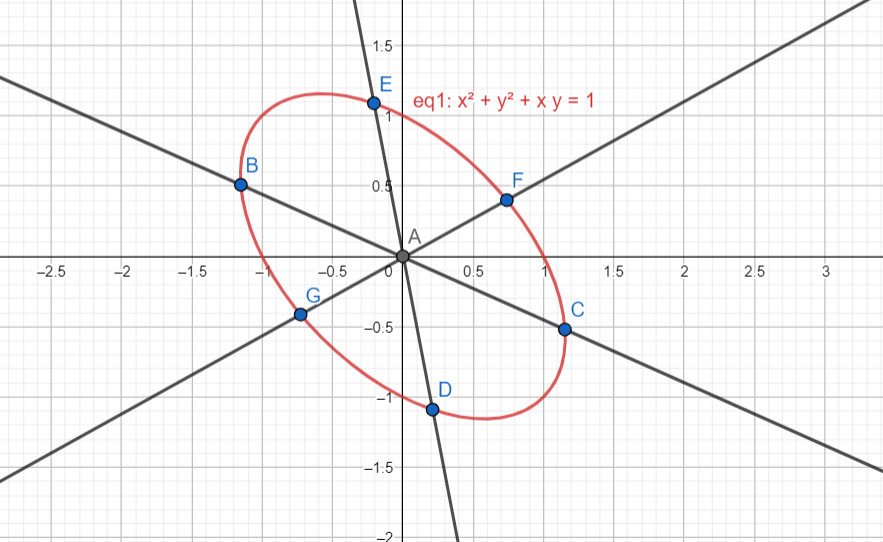
Any chord of the conic ${{x}^{2}}+{{y}^{2}}+xy=1$ passing through the origin is bisected at a point$(p,q)$ then $(p+q+12)$ equals to :
(a) 13
(b) 14
(c) 11
(d) 12
Answer
411.5k+ views
Hint: Make use of the property that says that the centre of a conic bisects every chord that passes through the centre of a conic section.
First, let’s find the centre of this conic section. To find this, let’s first see if the equation changes when we replace $x$ with $y$ and vice versa. If the equation remains unchanged, then that means that the centre of the conic is the origin itself.
Let’s exchange $x$ and $y$ in the equation now. Doing so, we get :
${{y}^{2}}+{{x}^{2}}+yx=1$ which is the same as the original question.
Hence, we know that the centre of this conic is in fact the origin.
It is a property of all conics that every chord drawn in the conic that passes through its centre is bisected by the centre of that conic. Applying this property to this question, since we don’t have one particular chord, and it’s any chord passing through the origin, we can say that $(p,q)$ is actually the centre of this conic. Hence, this point should be equal to the origin since that is the centre of this conic.
$\begin{align}
& (p,q)=(0,0) \\
& \Rightarrow p=0,q=0 \\
& \Rightarrow p+q+12=0+0+12=12 \\
\end{align}$
Hence, $(p+q+12)=12$ in this question.
Note:

Here, A is the centre of the conic, the origin, and as you can see, it bisects every chord that passes through it.
First, let’s find the centre of this conic section. To find this, let’s first see if the equation changes when we replace $x$ with $y$ and vice versa. If the equation remains unchanged, then that means that the centre of the conic is the origin itself.
Let’s exchange $x$ and $y$ in the equation now. Doing so, we get :
${{y}^{2}}+{{x}^{2}}+yx=1$ which is the same as the original question.
Hence, we know that the centre of this conic is in fact the origin.
It is a property of all conics that every chord drawn in the conic that passes through its centre is bisected by the centre of that conic. Applying this property to this question, since we don’t have one particular chord, and it’s any chord passing through the origin, we can say that $(p,q)$ is actually the centre of this conic. Hence, this point should be equal to the origin since that is the centre of this conic.
$\begin{align}
& (p,q)=(0,0) \\
& \Rightarrow p=0,q=0 \\
& \Rightarrow p+q+12=0+0+12=12 \\
\end{align}$
Hence, $(p+q+12)=12$ in this question.
Note:

Here, A is the centre of the conic, the origin, and as you can see, it bisects every chord that passes through it.
Recently Updated Pages
Glucose when reduced with HI and red Phosphorus gives class 11 chemistry CBSE

The highest possible oxidation states of Uranium and class 11 chemistry CBSE

Find the value of x if the mode of the following data class 11 maths CBSE

Which of the following can be used in the Friedel Crafts class 11 chemistry CBSE

A sphere of mass 40 kg is attracted by a second sphere class 11 physics CBSE

Statement I Reactivity of aluminium decreases when class 11 chemistry CBSE

Trending doubts
10 examples of friction in our daily life

Difference Between Prokaryotic Cells and Eukaryotic Cells

One Metric ton is equal to kg A 10000 B 1000 C 100 class 11 physics CBSE

State and prove Bernoullis theorem class 11 physics CBSE

What organs are located on the left side of your body class 11 biology CBSE

Define least count of vernier callipers How do you class 11 physics CBSE




